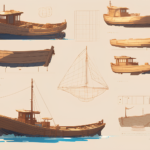Imagine turning a pile of plywood and resin into a personal watercraft. This dream can become a reality with DIY boatbuilding. It’s a challenge for those who love to craft and are eager to learn.
Building a homemade boat like the Minimede 368 takes patience and precision. You’ll need to cut plywood carefully and understand hull design. It’s about turning raw materials into a working vessel.
Creating your own dinghy is more than building a boat. It’s about learning maritime engineering and honing your craftsmanship. You’ll also feel the joy of sailing a vessel you built yourself.
Key Takeaways – How to Build a Dinghy
- DIY boatbuilding requires careful planning and specialized skills
- Proper material selection is key for a successful small craft fabrication
- Patience and precision are vital in homemade boat construction
- Learning boat design principles boosts your building success
- Safety and structural integrity are critical in dinghy construction

Understanding the Basics of Dinghy Design
Getting into dinghy construction means learning about boat design and how it works. When you design a custom dinghy, you think about many things. These things help the boat perform well and be easy to use.
Dinghies are a mix of engineering and boat-making skills. They are used for fun sailing and getting around on the water.
Types of Dinghies
Dinghy building covers a few main types:
- Rowing dinghies: Made for rowing
- Sailing dinghies: Have sails for sailing
- Motor-powered dinghies: Use engines for moving
“The art of dinghy design lies in balancing form, function, and performance.” – Maritime Design Expert
Key Components of a Dinghy
Knowing what makes a good dinghy is key. Important parts include:
- Hull: The main body of the boat
- Transom: The back part of the boat
- Seats: Help keep people stable and comfortable
- Storage compartments: Useful for carrying gear
When you design a dinghy, consider a few things:
- Length: Affects how well the boat performs and how much it can carry
- Beam: The width of the boat, which affects how stable and easy to steer it is
- Depth: How deep the boat is, which affects how much water it displaces and the space inside
Building a good dinghy needs attention to detail. Wide bows help with stability, while narrow sterns make the boat easier to handle. Every design choice affects how well the boat works and how enjoyable it is to use.
Unlock the secrets to building your dream boat with MyBoatPlans! With detailed plans for over 518 boats and expert video tutorials, you’ll have everything you need to create your perfect vessel. Click here to begin your journey!”
Tools and Materials You’ll Need
Starting a boat building project needs good planning and the right tools. You’ll need precision, quality tools, and materials to make a strong and seaworthy dinghy.
Before you start building your dinghy, get the essential tools. They will make your project smooth and fun.
Essential Tools for Building
- Cordless drill with multiple drill bits
- Jigsaw for precise cutting
- Random orbital sander
- Measuring tape and carpenter’s square
- Clamps (various sizes)
- Protective safety gear
Recommended Materials for Construction
Choosing the right materials is key in nautical woodworking. Your dinghy’s strength comes from quality parts.
- Marine-grade plywood (¼ inch thick)
- Epoxy resin
- Fiberglass cloth (6 oz weight)
- Marine paint
- Wire ties for stitch-and-glue method
- Cabosil filler
“The heart of boat building lies in choosing materials that can withstand maritime challenges.”
Always pick quality over price. For example, a good 5-ply exterior plywood sheet is under $80. Marine-grade plywood sheets are about $30 each. Spending more on materials means your dinghy will look great and last long.
Material Quantities for Your Project
- Fiberglass cloth: 8 yards of 6 oz bidirectional cloth
- Polyester resin: 1.5 gallons
- Ring shank nails: Approximately 200
Choosing the right tools and materials is the first step to a great boat building project in nautical woodworking.
Planning Your Dinghy Project
Starting a DIY boatbuilding project needs careful planning. As an amateur shipwright, you must do thorough research and plan your design well. Creating your own dinghy begins with a solid plan and realistic goals.
Creating a Design Blueprint
Designing your dinghy involves several key steps:
- Sketch initial designs on graph paper
- Consider hull shape for optimal performance
- Measure each component precisely
- Create detailed technical drawings
“A well-planned design is half the battle in successful DIY boatbuilding.”
Setting a Realistic Budget
Planning your budget is essential for DIY boatbuilding. Break down your costs:
- Materials cost (plywood, epoxy, fiberglass)
- Tool investments
- Contingency funds for unexpected expenses
- Optional equipment and finishing materials
Pro tip: Build a small prototype first. It saves time and money while improving your skills.
Typical material costs for a basic dinghy project are $500 to $1,500. This depends on your design and material quality.
Preparing Your Workspace
Starting a small craft project needs a well-prepared workspace. Your journey in building a dinghy begins with setting up the right space. The location you choose can greatly affect your experience.
Choosing the Perfect Location
Finding the perfect spot for your boatbuilding project is key. Think about these important points:
- Minimum space requirement: At least 10×10 feet area
- Flat, level surface for accurate measurements
- Indoor locations like garage or dedicated workshop preferred
- Protection from direct sunlight and extreme temperatures
Safety Considerations in Your Workspace
“Safety doesn’t happen by accident. It requires intentional preparation and constant awareness.”
Working on small craft projects comes with risks. Here are vital safety steps to take:
| Safety Item | Purpose |
|---|---|
| Fire Extinguisher | Immediate fire protection |
| First Aid Kit | Emergency medical response |
| Protective Gear | Personal safety during construction |
Important protective gear includes:
- Safety glasses
- Respirator mask
- Work gloves
- Protective hearing equipment
Pro tip: Ventilation is key in backyard boatbuilding. Ensure proper air circulation, specially when working with epoxy and paints.
Step-by-Step Guide to Building the Hull
Building a dinghy hull is all about precision and planning. It’s the heart of boat building, where your design turns into reality. You’ll transform raw materials into a strong boat ready to sail on waves.
Shaping the Frame
Starting a dinghy hull means making a solid frame. Experts say to use several methods:
- Choose top-notch marine-grade plywood
- Make accurate formers with templates
- Place formers on a strong base
- Make sure everything is symmetrical
*”The frame is the skeleton of your boat – get it right, and everything else falls into place.”*
Applying the Fiberglass Resin
Fiberglass resin adds strength and keeps water out. The process needs careful attention:
- Clean the hull well
- Mix the resin as the maker says
- Spread fiberglass cloth evenly
- Get rid of air bubbles carefully
Experts like Steve Goodchild suggest using WEST SYSTEM epoxy for the best bond. This resin makes your dinghy stronger and better at handling water.
| Construction Method | Complexity | Durability |
|---|---|---|
| Carvel Planking | High | Excellent |
| Lapstrake | Medium | Good |
| Stitch-and-Glue | Low | Very Good |
Picking the right building method is key for a great dinghy. Each way has its own benefits in boat making.
Installing the Dinghy’s Components
After finishing the hull, the next step is installing the internal parts. This turns your hull into a real boat ready for the sea.
Installing the parts needs precision and planning. The success of your dinghy depends on how well you put these parts together.
Download over 500 Boat Plans. Click on the link below.
-->Click Here<--
Adding Seats and Storage
Seats are key for safety and function. Use materials that can withstand the sea:
- Select marine plywood for seat construction
- Use epoxy resin for waterproofing
- Consider built-in flotation compartments
Transom Installation Techniques
The transom is a vital part of the boat. It holds the engine and adds strength to the hull.
| Transom Material | Recommended Usage | Durability Rating |
|---|---|---|
| Marine Plywood | Standard Dinghies | High |
| Fiberglass Reinforced | Heavy-Duty Boats | Very High |
“A well-installed transom is the backbone of your dinghy’s structural integrity.” – Traditional Boatbuilding Expert
When installing the transom, make sure to strengthen areas like oarlock sockets and engine mounts. This ensures your dinghy can handle different sea conditions.
Painting and Finishing Touches
Finishing your custom dinghy design needs careful attention to painting and finishing. The right steps can turn your handcrafted vessel into a professional-looking watercraft.
Selecting the Perfect Marine Paint
Choosing the right paint is key for protecting your homemade boats. Marine-grade paints offer top-notch protection against water, UV rays, and environmental challenges.
- Consider marine-specific paint brands designed for boats
- Match paint to your dinghy’s specific hull material
- Select colors that resist fading and provide maximum protection
Preparation Techniques for a Flawless Finish
Surface preparation is vital for your custom dinghy design. Professional boat builders say 50% of a great paint job happens before painting.
| Preparation Step | Recommended Technique |
|---|---|
| Sanding | Use 220-grit sandpaper for smooth surface |
| Cleaning | Remove all dust and debris thoroughly |
| Primer Application | Apply marine-grade primer evenly |
Application Tips for Professional Results
Technique is as important as materials when painting your homemade boats. Thin, even coats are better than thick, uneven ones.
Pro tip: Use white foam rollers and always roll in one direction to minimize bubbles and achieve a glossy finish.
- Apply multiple thin coats instead of one thick coat
- Allow proper drying time between layers
- Use Penetrol to improve paint flow and delay drying
- Consider adding non-slip surfaces for safety
Your custom dinghy design deserves a professional finish. Take your time, be patient, and enjoy transforming your handcrafted boat into a stunning watercraft.
Preparing for Launch
Building a dinghy at home is a big deal for an amateur shipwright. Months of work lead up to the launch. It’s a moment filled with excitement and importance. The right preparation ensures your boat will be safe and efficient on the water.
Essential Pre-Launch Checks
Before you launch your dinghy, do a detailed check. This is to make sure it’s ready for the water. Your hard work will be tested in this moment.
- Inspect all seams for watertightness
- Test hull integrity and flotation
- Verify all fittings are securely attached
- Check rudder and oarlocks for proper alignment
Launch Readiness Checklist
| Item | Status Check |
|---|---|
| Drain Plug | Installed and secure |
| Safety Equipment | Life jackets, bailer present |
| Trailer Preparation | Correctly positioned at launch site |
Registering Your Dinghy
Registering your dinghy is a key step after building it. Make sure it meets local maritime laws.
“Preparation is the key to a successful and safe maiden voyage.” – Experienced Boat Builder
With careful preparation, your dinghy will be ready for adventure. It will be a reliable watercraft.
Caring for Your Dinghy
After you finish building your dinghy, keeping it in good shape is key. This care helps your dinghy last longer and sail better. Building a dinghy is more than just the first step; it’s a lifelong commitment to care and upkeep.
Essential Maintenance Tips
Keeping your handmade boat safe needs a smart plan. Here are some important tips:
- Rinse with fresh water after each saltwater use
- Inspect high-stress areas like transom and oarlock sockets
- Touch up paint and varnish to protect wood or fiberglass surfaces
- Remove any moisture or debris after sailing
Winter Storage Strategies
It’s vital to winterize your dinghy to keep it strong. Wooden boat builders suggest these steps:
- Clean thoroughly before storage
- Remove all removable gear and equipment
- Store in a dry, covered area
- Use a breathable cover if outdoor storage is necessary
“A well-maintained dinghy is a sailor’s most trusted companion.” – Traditional Nautical Wisdom
Remember, caring for your dinghy is an ongoing task. Regular checks and early maintenance keep your boat ready for the sea for many years.
Troubleshooting Common Issues
When you start building a boat, you might face unexpected problems. It’s important to know how to fix wear, damage, and stability issues. This guide will help you solve common problems while building your dinghy at home.
Repairing Damage and Wear
The bow and transom are the most stressed parts of a boat. To strengthen them, add more fiberglass or marine-grade wood. It’s vital to fix wear quickly with epoxy and the right techniques.
Resolving Stability Concerns
Stability is key in boat building. If your dinghy is unstable, try changing the seating or adding ballast. Boat builders suggest using quality materials and careful weight distribution.
Regular checks and maintenance will keep your dinghy safe for years. Spend time learning about your boat’s needs and fix issues early to avoid big problems.
FAQ – How to Build a Dinghy
How much does it cost to build a dinghy at home?
Building a dinghy at home can cost between $300 and $1,500. You’ll need marine-grade plywood, epoxy resin, and fiberglass cloth. Basic tools are also essential. For a simple rowing dinghy, you might spend around $500. More complex designs could cost up to $1,500.
How long does it take to build a dinghy?
Building a dinghy can take 2 weeks to 3 months. It depends on your skill level and how much time you have. Beginners should plan for 6-8 weeks. More skilled builders might finish faster.
Do I need special woodworking skills to build a dinghy?
You don’t need advanced woodworking skills. Basic knowledge and the ability to follow instructions are key. Many builders start as hobbyists and learn as they go.
What’s the best type of dinghy for a first-time builder?
A simple rowing dinghy is best for beginners. Look for designs that are easy to follow and have fewer parts. Chesapeake Light Craft offers great plans for beginners.
What safety equipment do I need for my homemade dinghy?
You’ll need life jackets, a bailer, paddle or oars, a whistle, and a first aid kit. You might also need navigation lights and an anchor. Always check local boating laws for specific requirements.
Can I use my homemade dinghy in saltwater?
Yes, but you must take precautions. Use marine-grade materials and apply protective coatings. Rinse the dinghy with fresh water after each use to prevent corrosion.
How do I store my dinghy during the off-season?
Store your dinghy in a dry, covered area. If you must store it outside, use a breathable cover. Clean it thoroughly, remove all gear, and apply a protective sealant. Store it off the ground to prevent moisture damage.



